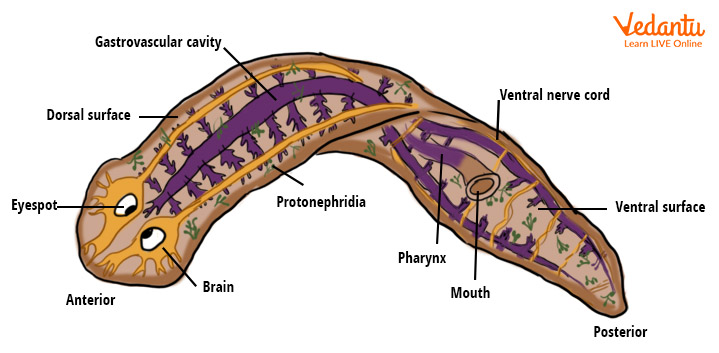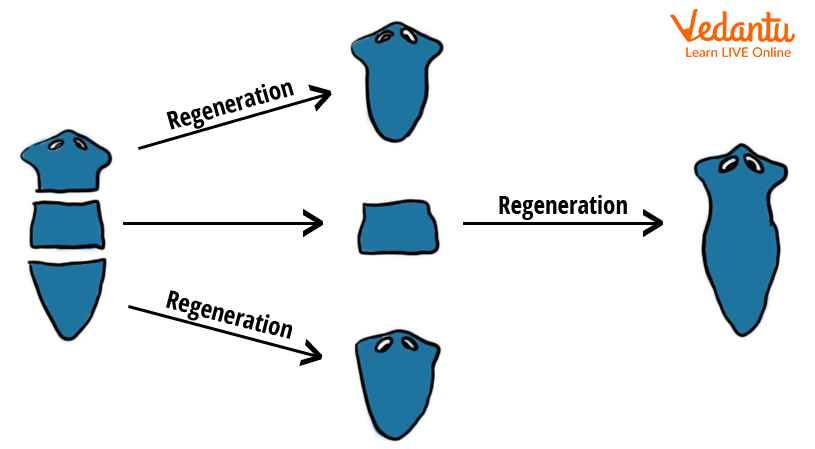Key Features of Planaria and How Their Nervous System Works
The phylum Platyhelminthes is a major phylum of the kingdom Animalia. It constitutes flatworms that are segmented and bilaterally symmetrical. There are several parasitic varieties of flatworms, some of which are quite harmful to human populations. Planaria is among the many examples of flatworms in Platyhelminthes. Planarians have been studied extensively over the last century for their regenerative properties and more recently as a model for stem cell biology.
What is Planaria?
Planaria are flatworms belonging to the phylum Platyhelminthes that have incredible regeneration ability, earning them the nickname "immortal under the knife." Freshwater, marine, and terrestrial habitats all have a diverse range of organisms. The majority of planarians live in freshwater and can be found in huge groups; some species are marine, while others are terrestrial. Some species are parasitic, meaning they feed on other living creatures’ bodies.
Scientific Classification and Diagram of Planaria
Planaria Classification
Kingdom: Animalia
Phylum: Platyhelminthes
Class: Rhabditophora
Clade: Adiaphanida
Order: Tricladida
Family: Planariidae
Genus: Planaria
Planaria Diagram

Structure of Planaria
Anatomy of Planaria
When extended, the body is soft, leaf-shaped, and ciliated. Two eyes and tentacles can be found on the spade-shaped head. The tail is angular. The mouth is located on the ventral (lower) side of the animal, frequently more than halfway to the tail. There is no body cavity or coelom. The pharynx, which may extend from the mouth, leads to a normally blind gut. The length ranges from 3 to 15 mm (0.1 to 0.6 inches), with some reaching more than 30 cm (approximately 1 foot) in length. Species from the tropics are frequently brilliantly coloured. Dugesia is a black, grey, or brown genus found in North America.
Planarians swim in an undulating pattern or move along the ground like slugs. The majority of them are carnivorous night feeders. Protozoans, small snails, and worms are among their favourite foods. All are simultaneous hermaphrodites, meaning they have both male and female reproductive organs in the same person. Early in the autumn, the reproductive organs begin to mature. In the spring, cocoons holding fertilised eggs are laid. In most species, fully developed young emerge and develop without metamorphosis (radical change). However, in a few marine species, free-living, ciliated larvae are discharged. In some species, the organism in the cocoon divides into two halves, each of which grows into a complete individual. Buds form at the end of others of the genus Microstomum and can stay attached to the parent for a long time; chains of three or four buds have been seen. Planarians are frequently employed in experiments to explore the process of regeneration because of their exceptional capacity to restore missing portions.
The Nervous System of Planaria
Flatworms were the first invertebrates to acquire a central nervous system with a brain, as well as bilateral symmetry.
A brain, longitudinal nerve cords, and peripheral nerve plexuses (interlacing networks of peripheral nerves) make up the neurological system of a free-living flatworm-like Planaria.
The brain, which is placed in the front of the animal, is made up of two cephalic ganglia that are connected by a commissure.
Longitudinal nerve cords, usually three to five pairs, extend posteriorly from the brain; transverse commissures connect them, and smaller, lateral nerves emerge from the cords.
The peripheral nerve plexuses are formed by the lateral nerves. The submuscular nerve plexus, which consists of sensory cells, ganglion cells, and their processes, is located beneath the subepidermal musculature in loose tissue (mesenchyme). Above the muscle layer, another subepidermal plexus is found at the bases of epithelial cells.
Planaria nervous system has a plethora of sensory receptors.
The nerve plexuses include single sensory cells that are extensively dispersed throughout the organism.
Ciliated pits and grooves, auricles, the frontal organ, statocyst, and eyeballs are among the sensory organs present.
Chemical receptors, or chemoreceptors, are found in the ciliated pits and grooves, allowing the animal to detect food. The statocyst is in charge of balance and reflexes like rising to the water's surface or sinking.
How does Planaria reproduce?

Regeneration in Planaria
Planaria have both male and female sex organs, making them hermaphroditic. The ovaries are found near the eyespots in a rostral direction. Of course, this is not the same as the human ovaries, which are located in the lower abdominal cavity! A single egg cell is produced by the ovaries of planarians. Testes and seminal ducts, which together make and carry sperm, are positioned laterally along the sides of the body. A penis is also present in planarian worms, which are contained in a genital chamber. Nutrients are delivered to eggs via specialised yolk glands.
Sexual Reproduction: Planarian worms have both testes and ovaries, as well as the ability to generate both sperm and eggs. Sexual reproduction, on the other hand, occurs when one flatworm transports sperm to the seminal receptacle of the recipient flatworm via the penile duct. In the seminal receptacle, the recipient's egg is fertilized and transmitted outside the body into the planarian worm's liquid environment. A thin mucous filament is usually used to bind the egg to a surface in the liquid.
Asexual Reproduction: Planaria have the power to create new persons from the components of their bodies. This is referred to as regeneration. Planaria's body can be cut or broken into several pieces, each of which grows into a whole organism. Regeneration varies from reproduction in that regeneration can occur from any part of the organism, such as a lizard's damaged tail. Reproduction, on the other hand, is the process through which a new organism is created from specialised cells known as gametes. Furthermore, regeneration does not always result in the emergence of a new person, whereas reproduction always results in the emergence of new individuals from the parent organism.
Conclusion
In many regions of the world, planaria are widespread. In freshwater ponds and rivers, planaria typically dwell beneath rocks or aquatic plants. Salinity is the home of several marine animals. In humid environments, several terrestrial species can be found on or in the soil, under logs, and on plants. Polluted water is intolerable to planaria. They are frequently researched as bio-indicators in an aquatic habitat as a result.
The most striking feature of planaria is its ability to regenerate itself when cut with a knife.


FAQs on Planaria: Classification, Structure, and Nervous System
1. How are Planaria classified taxonomically?
Planaria are simple flatworms that belong to the Kingdom Animalia. Their classification is as follows:
Phylum: Platyhelminthes (meaning flatworms).
Class: Turbellaria, which includes most non-parasitic, free-living flatworms.
Order: Tricladida.
Genus: Common freshwater planarians studied in labs, like Dugesia, fall under this classification.
They are distinct from parasitic flatworms like flukes (Class Trematoda) and tapeworms (Class Cestoda). For more details on this phylum, you can refer to Vedantu's guide on Phylum Platyhelminthes.
2. What are the key physical characteristics and habitat of Planaria?
Planaria are known for their simple yet distinct features. They are dorsoventrally flattened (flat from top to bottom), bilaterally symmetrical, and typically range from 3 to 20 mm in length. Key characteristics include:
Head Region: They show cephalization with a triangular head containing two eyespots (ocelli) that can detect light intensity.
Body: Their soft, unsegmented body is covered in cilia, especially on the ventral (belly) side, which helps them glide through water.
Habitat: Most Planaria are free-living and are found in freshwater environments like ponds, streams, and lakes, often hiding under rocks or debris.
3. Why are Planaria famous for regeneration, and is it a form of reproduction?
Planaria are famous for their extraordinary ability to regenerate due to a large population of adult stem cells called neoblasts distributed throughout their body. If a planarian is cut into multiple pieces, each piece can regrow into a complete, genetically identical organism. This remarkable feat makes them a key model organism in stem cell research. Yes, this process is a form of asexual reproduction known as fragmentation, where the organism deliberately splits its body to produce new individuals. To learn more, explore the concept of Asexual Reproduction in detail.
4. Describe the digestive system of a Planarian.
Planaria have an incomplete digestive system, which means there is only one opening that serves as both a mouth and an anus. The system consists of three main parts:
Mouth: Located on the ventral (underside) surface, in the middle of the body, not at the head.
Pharynx: A muscular, tube-like structure that extends from the mouth to suck in food.
Gastrovascular Cavity: A three-branched internal cavity where food is digested by enzymes. The branches distribute nutrients directly to the cells, as they lack a circulatory system.
Undigested waste is expelled back out through the pharynx and mouth.
5. How do Planaria excrete waste? Explain the role of flame cells.
Planaria excrete metabolic waste through a specialised excretory system made of protonephridia. This system is a network of tubules running along the sides of the body. At the end of these tubules are specialised cells called flame cells. Each flame cell has a cluster of cilia that beats back and forth, resembling a flickering flame. This beating action creates a negative pressure, drawing waste fluids from the body into the tubules. The waste is then transported through the network and expelled from the body via small pores called nephridiopores.
6. Are Planaria parasitic, and do they pose a threat to humans?
No, the vast majority of Planaria species are free-living, not parasitic. They are harmless predators and scavengers in freshwater ecosystems, feeding on small invertebrates or dead organic matter. They are often confused with their parasitic relatives in the Phylum Platyhelminthes, such as tapeworms and liver flukes, which do cause diseases. Planaria themselves do not cause any diseases in humans and pose no threat.
7. What is the difference between regeneration in Planaria and fragmentation?
While related, fragmentation and regeneration are distinct processes. Fragmentation is the act of the body breaking into two or more pieces. This can happen accidentally or as a deliberate method of asexual reproduction. Regeneration is the biological process of regrowing lost or damaged tissues or body parts that follows fragmentation. In Planaria, regeneration is so complete that it serves as their primary mode of reproduction. You can explore a detailed comparison in this guide on the Difference Between Fragmentation and Regeneration.
8. What type of nervous system do Planaria have?
Planaria possess a simple, primitive nervous system that is more advanced than that of cnidarians like Hydra. It is often described as a ladder-like nervous system. It consists of:
A pair of cerebral ganglia (a simple brain) located in the head region, which coordinates nerve signals.
Two main longitudinal nerve cords that run down the length of the body.
Several transverse commissures (cross-connections) that link the two nerve cords, giving it the appearance of a ladder.
This structure represents an important evolutionary step towards the centralised nervous systems found in more complex animals.










